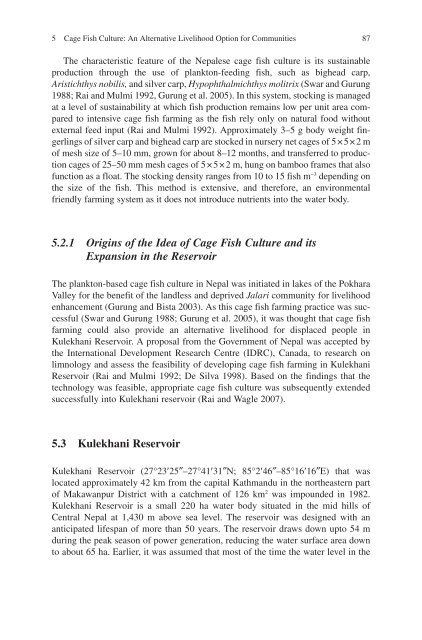Success Stories In Asian Aquaculture - Library - Network of ...
Success Stories In Asian Aquaculture - Library - Network of ...
Success Stories In Asian Aquaculture - Library - Network of ...
- No tags were found...
Create successful ePaper yourself
Turn your PDF publications into a flip-book with our unique Google optimized e-Paper software.
5 Cage Fish Culture: An Alternative Livelihood Option for Communities87The characteristic feature <strong>of</strong> the Nepalese cage fish culture is its sustainableproduction through the use <strong>of</strong> plankton-feeding fish, such as bighead carp,Aristichthys nobilis, and silver carp, Hypophthalmichthys molitrix (Swar and Gurung1988 ; Rai and Mulmi 1992 , Gurung et al. 2005) . <strong>In</strong> this system, stocking is managedat a level <strong>of</strong> sustainability at which fish production remains low per unit area comparedto intensive cage fish farming as the fish rely only on natural food withoutexternal feed input (Rai and Mulmi 1992) . Approximately 3–5 g body weight fingerlings<strong>of</strong> silver carp and bighead carp are stocked in nursery net cages <strong>of</strong> 5 × 5 × 2 m<strong>of</strong> mesh size <strong>of</strong> 5–10 mm, grown for about 8–12 months, and transferred to productioncages <strong>of</strong> 25–50 mm mesh cages <strong>of</strong> 5 × 5 × 2 m, hung on bamboo frames that als<strong>of</strong>unction as a float. The stocking density ranges from 10 to 15 fish m −3 depending onthe size <strong>of</strong> the fish. This method is extensive, and therefore, an environmentalfriendly farming system as it does not introduce nutrients into the water body.5.2.1 Origins <strong>of</strong> the Idea <strong>of</strong> Cage Fish Culture and itsExpansion in the ReservoirThe plankton-based cage fish culture in Nepal was initiated in lakes <strong>of</strong> the PokharaValley for the benefit <strong>of</strong> the landless and deprived Jalari community for livelihoodenhancement (Gurung and Bista 2003) . As this cage fish farming practice was successful(Swar and Gurung 1988 ; Gurung et al. 2005) , it was thought that cage fishfarming could also provide an alternative livelihood for displaced people inKulekhani Reservoir. A proposal from the Government <strong>of</strong> Nepal was accepted bythe <strong>In</strong>ternational Development Research Centre (IDRC), Canada, to research onlimnology and assess the feasibility <strong>of</strong> developing cage fish farming in KulekhaniReservoir (Rai and Mulmi 1992 ; De Silva 1998 ). Based on the findings that thetechnology was feasible, appropriate cage fish culture was subsequently extendedsuccessfully into Kulekhani reservoir (Rai and Wagle 2007) .5.3 Kulekhani ReservoirKulekhani Reservoir (27°23 ¢ 25″–27°41 ¢ 31″N; 85°2 ¢ 46″–85°16 ¢ 16″E) that waslocated approximately 42 km from the capital Kathmandu in the northeastern part<strong>of</strong> Makawanpur District with a catchment <strong>of</strong> 126 km 2 was impounded in 1982.Kulekhani Reservoir is a small 220 ha water body situated in the mid hills <strong>of</strong>Central Nepal at 1,430 m above sea level. The reservoir was designed with ananticipated lifespan <strong>of</strong> more than 50 years. The reservoir draws down upto 54 mduring the peak season <strong>of</strong> power generation, reducing the water surface area downto about 65 ha. Earlier, it was assumed that most <strong>of</strong> the time the water level in the
















